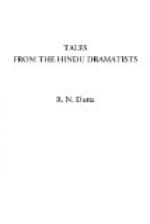The words for actor (nata) and play (nataka) are derived from the verb nat, the Prakrit or vernacular form of the Sanskrit nrit, “to dance.” Hence scholars are of opinion that the Sanskrit drama has developed out of dancing. The representations of dramas of early times were attended with dancing and gesticulation. There were rude performances without the contrivances of stage and scenic arrangements, dancing and music forming a considerable part. The addition of dialogue was the last step in the development, which was thus much the same in India and Greece. This primitive stage is represented by the Bengal Yaeras and the Gitagovinda. These form the transition to the fully developed Sanskrit play in which lyrics and dialogue are blended.
Sakuntala belongs to the mytho-pastoral class of Sanskrit plays; Probodhchandraudya, to the metaphysical. The Hindu theatre affords examples of the drama of domestic, as well as of heroic life; of original invention as well as of legendary tradition.
The Hindus did not borrow their dramatic compositions from foreigners. The nations of Europe possessed no dramatic literature before the fourteenth or fifteenth century, at which period the Hindu drama had passed into its decline. Mohammedan literature has ever been a stranger to theatrical writings, and the Mussalman conquerors of India could not have communicated what they never possessed. There is no record that theatrical entertainments were ever naturalised amongst the ancient Persians, Arabs, or Egyptians. With the exception of a few features in common with the Greek and the Chinese dramas, which could not fail to occur independently, the Hindu dramas present characteristic features in conduct and construction which strongly evidence both original design and national development.
Angustus William Von Schlegel observes:—
“Among the Indians, the people from whom perhaps all the cultivation of the human race has been derived, plays were known long before they could have experienced any foreign influence.”
THE CHARACTER OF THE HINDU DRAMA.
Sanskrit plays are full of lyrical passages describing scenes or persons presented to view, or containing reflections suggested by the incidents that occur. They usually consist of four-line stanzas. The prose of the dialogue in the plays is often very commonplace, serving only as an introduction to the lofty sentiment of the poetry that follows.
The Sanskrit drama is a mixed composition in which joy is mingled with sorrow, in which the jester usually plays a prominent part, while the hero and heroine are often in the depths of despair. But it never has a sad ending. The emotions of terror, grief, or pity, with which the audience are inspired, are therefore always tranquillised by the happy termination of the story. Nor may any deeply tragic incident take place in the course of the play; for death is never allowed to be represented on the stage. Indeed, nothing considered indecorous, whether of a serious or comic character, is allowed to be enacted in the sight or hearing of the spectators, such as the utterance of a curse, degradation, banishment, national calamity, biting, scratching, kissing, eating, or sleeping.




